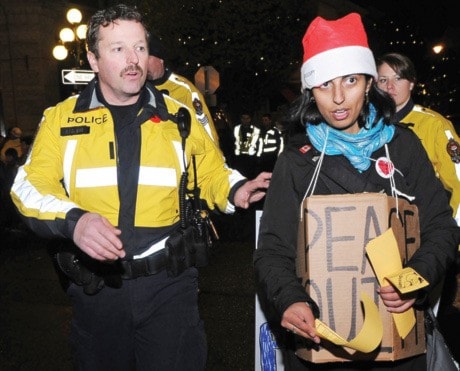At this time last year, Occupy landed in Victoria.
Tents, tarps and couches began to fill Centennial Square, launching the local incarnation of an already well-established international movement.
For six weeks, activists braved the fall weather before an injunction by the City of Victoria put an end to the encampment.
But even as tenters packed up and the square emptied last November, a common question buzzed on the lips of activists: what’s next?
“I really tried hard to keep it going by having assemblies and trying to raise issues I thought people could rally around,” said Robert Duncan, a member of the People’s Assembly of Victoria, which steered the protest by consensus. “People were swearing up and down that there was going to be a lot of camping again (in the) summer, but it didn’t happen.”
Inevitably the group dwindled, said Duncan, who works in a group home. “There is a lot of complacency. People don’t feel the issues are touching them in a major way – yet.”
So what happened to the movement?
One year later, the News caught up with four activists heavily involved with the People’s Assembly.
While the momentum of Occupy may have abated, they all insist it wasn’t a wasted effort. Rather, it sparked debate that continues today about poverty, activism and even the very definition of Occupy.
The lessons learned about resistance have energized other protests, said Anushka Nagji.
When faced with the city’s injunction last November, the law student used her training to launch a legal defence.
It failed, but Occupy Victoria “has inspired and created so many more cascading events and groups,” Nagji said from Vancouver, where she now studies.
She counts the so-called Casserole Protests among them.
When the Montreal student-tuition protests spread to other major cities in the spring, Nagji was twice arrested and spent the night in jail. “The second time I was beat up pretty bad; I had a cracked rib and was laid up for about a month,” she said.
Occupy also sparked connections, added Michelle Buchanan.
“Some really strong bonds were made in the camp last fall, and those continue to exist,” she said. “We were divided a little bit; you were an environmentalist or you were a social justice activist … and the camp had a great quality of bringing us all together to realize that our goals were very similar.”
While the People’s Assembly embraced an inclusive philosophy, it did not include everyone.
Buchanan was tasked with social media for the group and she struggled to distinguish its aims from a second group that lays claim to the word Occupy.
That struggle continues today, as both groups continue to organize events.
On Oct. 20, the local chapter of an anti-corruption movement called We Are Change will hold a rally under the banner “Occupy Victoria Returns.” (wearechangevictoria.org/)
Speakers at the “freedom and solutions” rally will focus on the flaws of the monetary system. Banks, rather than government, are issuing credit, explains organizer Josh Steffler. The system siphons off too much money to repay the debt, rather than to fund social programs, he continued.
Steffler’s group also believes in chem trails, a 9-11 cover up and a global warming fraud.
The People’s Assembly sees these ideas as hostile to their cause, but the rift does raise an interesting question.
What ideas can legitimately belong to Occupy when the movement itself defies specific aims and demands?
“They feel they have a monopoly, (but) nobody gets to define Occupy,” said Steffler.
For his part, Duncan dismisses the group as conspiracy theorists.
Occupy is generally understood to represent the consensus on the left, he said.
Nagji defines it in similarly broad terms, as resistance to oppression.
For many people, the lack of tangibility has made Occupy a hard sell.
It has also left the movement vulnerable to misinterpretation, admitted Terence Stone, another activist.
In August 2011, the 68-year-old clinical counsellor returned from a trip to India and South East Asia. There, he witnessed what he characterized as the “residual oppression” of colonization and war.
Getting involved with the People’s Assembly seemed a natural fit.
Using his large stock pot, Stone cooked up big batches of spicy peanut soups and hauled them to Centennial Square to share. Occupy connected people to poverty and homelessness in a profound way, he said.
But in the wider community, there were huge misunderstandings, Stone said.
The protest was attacked for not having specific demands. However, that was also its strength, he said. Rather than proposing solutions, Occupy was about posing the right questions.
“Young people and old people were asking questions,” he said. “What is happening right now, in terms of corporatism? How is that control manifest? How is it hidden from us?”
These are the important questions to ask moving forward, he said.
At this point, the activists don’t predict a re-Occupy movement in the near future. They do, however, describe a resurgence as likely at some point. Duncan predicts the global economic crisis is just ramping up.
“It will make the 1930s look like child’s play,” he said.
Occupy formed a network of activated people who are just below the surface; when the crisis hits, he said, “a community could be reactivated in an instant.”
rholmen@vicnews.com
Upcoming protest to defend coast
The people behind Occupy Victoria and Occupy Vancouver turn their attention to B.C.’s coast on Monday (Oct. 22).
A mass sit-in at the legislature, protesting the rising threat of pipelines and tankers, aims to send the message “the West Coast is not for sale.” Anyone who wants to participate in the day of action is asked to attend a one-day training session this Sunday.
On Oct. 24, activists across the province will get involved by linking arms at their local MLA offices.
For more information on the protests, visit occupyvictoria.ca or defendourcoast.ca.
